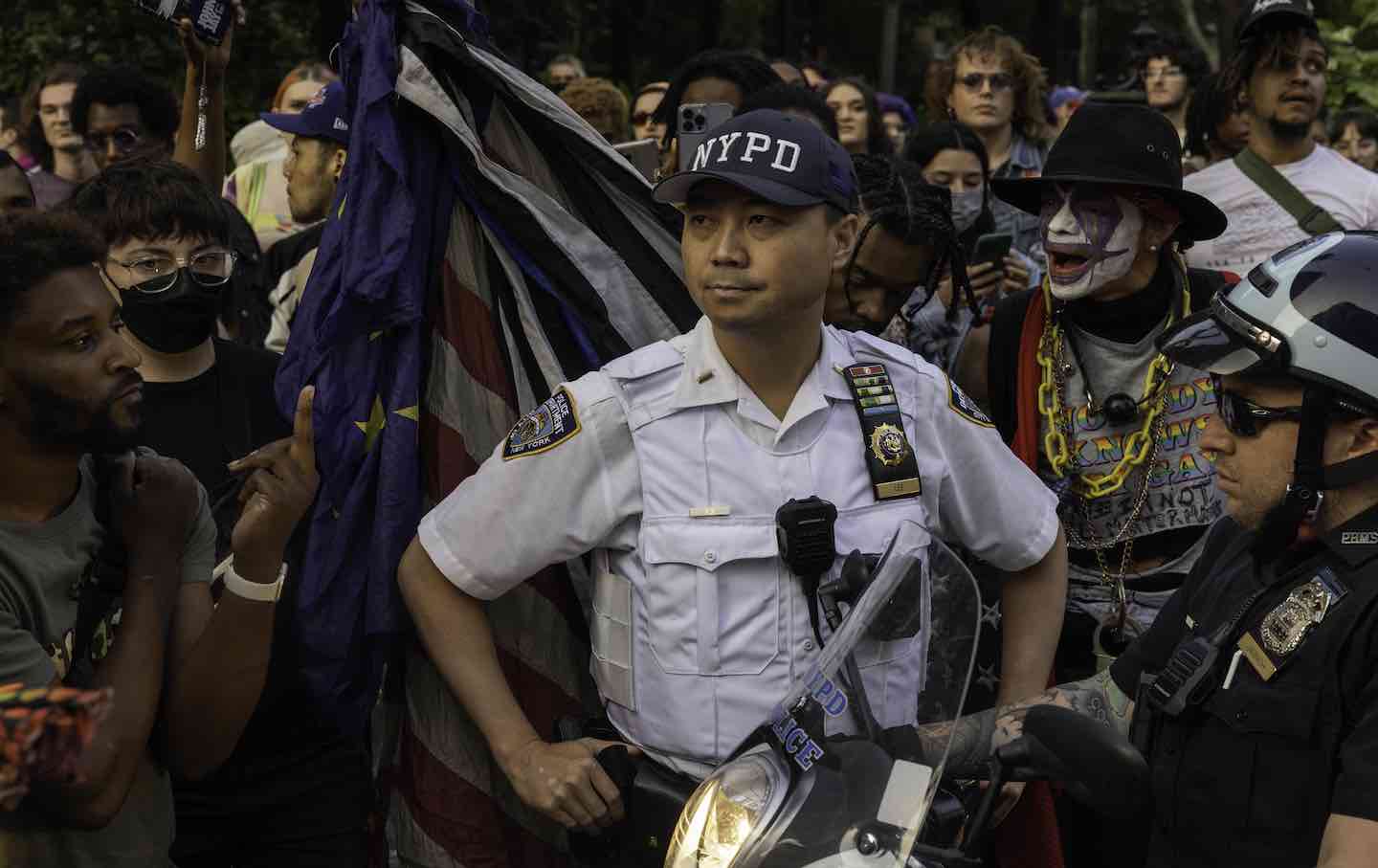How Gender Is Policed in America
Paisley Currah’s wide-ranging study Sex Is as Sex Does examines how transphobia emerged in America as a result of contradictory and self-serving sex classification policies.

Early in Sex Is as Sex Does, Paisley Currah tells the story of Jane Jones, who was arrested in Idaho in 1994 for “marriage under false personation.” Jones had not intended to mislead anyone. She had wed her husband legally, using her real name. But when police arrived at her home to investigate her husband for writing bad checks, his alleged deceit was upstaged by Jane’s: Her driver’s license listed one name and sex, her marriage certificate another. Jones identified, lived, and was perceived as a woman, a fact recognized by the county clerk who issued her marriage certificate. But because Jones (who was transgender) had not registered her sex with the Idaho Department of Motor Vehicles, her driver’s license still read “M.” In the eyes of her arresting officer, this made Jones and her husband’s union a same-sex marriage and therefore illegal in Idaho at the time.
Books in review
Sex Is as Sex Does: Governing Transgender Identity
Buy this book“Who gets to decide whether the woman who spent the night in an Idaho county jail is a man or a woman?” Currah asks. Today, many would say Jones’s self-determined account of her sex is the only answer we need. (Indeed, one of the great successes of the trans rights movement has been to popularize the notion that sex and gender are inviolable expressions of personhood defined by each of us for ourselves.) Others might counter with a definition of their own: Sex is a fact established at birth by doctors or God. For decades now, trans advocates and their antagonists have squared off over this question of what sex is.
But Currah, you may have noticed, asked something else. Competing conceptions of sex and gender have long existed, Currah acknowledges, and some stand on firmer ethical or scientific ground than others. But abstract debates about how to define sex are conditioned by the more concrete question of who has the power to make these judgments. Currah’s book surveys disputes over the meaning of manhood and womanhood as they have played out across a range of legal and administrative contexts, from divorce courts to prisons to municipal records bureaus, over the past half-century. One combatant, Currah contends, has unique authority to settle these definitional contests: the state. When Jones’s account of her sex was contradicted by the Idaho deputy sheriff, only the officer had the power to make his determination matter. In place of definitions both psychological and anatomical, liberating and constraining, Currah offers his own: “Sex is whatever an entity whose decisions are backed by the force of law says it is.”
On first read, the thesis of Sex Is as Sex Does may seem to sweep away decades of careful inquiry into the nature of sex and gender by feminist, queer, and transgender thinkers. Academic debates about essentialism, social construction, and the sex/gender dichotomy are traced only in outline; they mainly feature in Sex Is as Sex Does as theoretical quicksand to be respectfully sidestepped. Currah employs a sex/gender distinction of his own, defining the latter as the “norms, narratives, practices, and conventions that arrange bodies, identities, roles, and expressions in hierarchies of difference”—but he invokes these social and cultural aspects of gender only in order to set them aside. Within the purview of his book’s argument, the more significant battles take place in the realm of the state. Sex, for Currah’s purposes, refers to those “classifications of male or female backed by the force of law.”
If Currah risks appearing to dispel the subtleties of theory with the harsh light of force, he does so in order to bring other nuances into view. Sex may be whatever the state says it is, but the state speaks in multiple voices. Its pronouncements on sex have been subject to dramatic regional and institutional discrepancies, and the state’s hydra-headed response to people like Jane Jones is a consequence of this fact. Jones’s documents, after all, were both issued by state agencies. The Idaho county clerk presumably didn’t consult with the DMV before issuing Jones’s marriage certificate, nor did her arresting officer call up either agency before taking her to jail.
For most Americans, the DMV is the paradigmatic scene of state-mandated tedium. In Sex Is as Sex Does, it becomes a dynamic arena of everyday existential conflict. Currah’s argument emerges from a meticulous assessment of policies for sex classification and reclassification, or the rules and guidelines by which bureaucrats at the DMV, the Social Security Administration, and other government offices determine an individual’s sex and permit some trans people to revise that designation. While these bureaucratic encounters appear neutral and even boring to those who navigate them frictionlessly, for trans people they carry steep risks. Misalignments between “the sex one believes oneself to be and the sex a state institution says one is” have historically triggered the denial of “rights and privileges that are distributed based on sex,” Currah asserts, pointing to invalidated marriages, severed parental relationships, and lost jobs. Sex classification shapes everyone’s access to a host of resources and institutions, including travel documents, welfare programs, drug treatment centers, homeless shelters, and, yes, bathrooms. It also influences one’s fate in the more explicitly punitive corners of the state—at immigration facilities and in prisons.
Advocates have fought hard to secure recognition for trans people across these contexts, but as they made halting progress in the 1990s and 2000s, predicaments like Jones’s became more, rather than less, common. Different agencies, municipalities, and states adopted reforms at a different pace, resulting in a tangle of competing criteria and requirements for reclassification. At the time of her arrest, Jones could have changed the sex recorded on her driver’s license by presenting a letter from her physician to the DMV, but the Idaho Office of Vital Statistics would still have refused to revise a birth certificate under any circumstances (a policy that only changed in 2018).
Rather than rush to resolve these contradictions, Currah invites us to consider how they came to be and how they might serve rather than impede the state’s aims. Just as there is no single universal truth about the nature of sex, there is no single omnipotent state apparatus implementing a grand design. Sex classification rules have instead evolved piecemeal, through the decisions of disparate administrators and judges. These rules and decisions may at times be expressed in the language of animus toward or measured acceptance of trans people, but Currah argues that they are usually made with an eye toward the imperatives of the agency in question.
In one chapter, Currah charts five decades of debate in New York City over the criteria by which trans people should be allowed to change the sex recorded on their birth certificates. Currah, a professor at Brooklyn College and the CUNY Graduate Center, was among the experts who tried to convince the city to liberalize its policies by explaining that an individual’s avowed gender identity, rather than their desire or ability to pursue genital surgery, is the most accurate basis for determining their sex. But the New York City Board of Health cared less about the proposed policy’s rationale than its potential effects. City officials feared that any reform would have unforeseen consequences for the many different municipal agencies in which sex serves as a tool of governance.
Currah finds an even more compelling example of this instrumental calculus at the DMV. By the early 2000s, nearly every state permitted trans people to alter their designated sex on driver’s licenses, in most cases without any requirement of genital surgery. In these same years, however, state courts reliably invalidated marriages like Jones’s in which one spouse was transgender, on the grounds that one’s sex was fixed at birth and these unions were illegal same-sex marriages. Here, too, any apparent incongruity dissolves, Currah insists, if we consider how “these dissimilar constructions of sex furthered different government projects.” It is in the state’s interest for the information contained on a driver’s license to accurately describe its bearer. To effectively police people’s movements, a traffic cop or a TSA agent needs to be able to recognize the congruence between an identity document and the person presenting it.
Marriage, by contrast, is a tool the state uses to distribute resources and obligations, structuring the transmission of property between spouses and across generations. Recognizing trans people’s self-identification would do nothing to facilitate this task, as it does in the context of identity documents. In each of the marriage cases Currah examines, the litigants had clear, competing material interests: A physician hoped to evade a medical malpractice suit by contesting a trans widow’s standing; a son challenged his trans stepmother’s inheritance claims after his father’s death; an embittered spouse petitioned to have her trans husband’s parental rights revoked during divorce proceedings. The state rediscovers its interest in transphobia whenever cis people have something to lose.
Despite the apparent transphobic rationale—and clear transphobic outcomes—of many of the cases Currah investigates, he argues that presuming transphobia is their motive can obscure as much as it explains. Much academic and advocacy work has operated under what Currah calls “the trans-vs.-cis analytic paradigm,” in which transgender names a diverse but coherent category of people, united in their oppression by gender norms. But the forms of sex classification that Currah investigates—driver’s licenses, birth certificates, documents of marriage law, and so on—“were not put in place to target transgender populations.” These rigidly binary sex classification schemes were originally designed and implemented not out of hostility toward trans people but in ignorance of them. Throughout most of US history, trans people have become visible to the state less as a targeted minority to suppress than as “an unanticipated or abnormal situation,” forcing revisions to the state’s available categories for classifying its citizens.
Popular
“swipe left below to view more authors”Swipe →In what seems to me to be one of the book’s most important but understated interventions, Currah points out, at the root of apparent transphobia, a longer history of sexism. “In European and, later, American legal traditions,” he writes, “gender difference was codified in laws designed” not to exclude trans people but “to limit the rights and resources available to” women. The law needed to distinguish between M and F to control access to property, the vote, divorce, redress for sexual violence, and countless other entitlements and protections meted out along gendered lines. In combating these forms of discrimination, feminists made sex reclassification more palatable by lowering its stakes. When “an F designation can no longer be used to curtail” people’s rights, the state loses much of its incentive to vigorously police the M/F boundary.
Currah hopes that looking beyond transphobia in this way will help trans and feminist activists see what they have in common. This is a worthy and urgent goal. But some of his own examples are hard to make sense of without transphobia. What other name should we give to the reaction that Jones seems to have provoked in her arresting officer, who not only rejected her account of herself but took her to jail for it? How else might we describe the beliefs that led the judges in those early 2000s marriage cases to side so consistently against trans litigants? While the state may have had no bureaucratic reason to recognize trans people’s declared sex for the purposes of marriage, neither did it have a clear motive to deny it. “Transphobia” still seems to me the most apt word for both the rationale and the results of these judgments.
Yet even if we don’t fully accept Currah’s argument about transphobia, Sex Is as Sex Does still offers some essential cautions. His most convincing critique of the “trans-vs.-cis” framework concerns its tendency to collapse a vast range of experiences into a single type of person (trans- or cisgender) struggling against a single form of harm. Forgoing the language of transphobia, Currah argues, allows us to better distinguish between different kinds of trans experiences, which in turn enables us to pay closer attention to how race, class, and context conspire with sex to “produce inequality.”
Currah elaborates on this insight in the context of incarceration. Prisons, he notes, are sites of extreme violence against trans people, who are routinely mis-placed in sex-segregated facilities, denied access to gender-affirming medical care, targeted for physical and sexual assault by staff and fellow prisoners, and isolated in solitary confinement (often for their own “protection”). Seen in one light, these forms of violence appear as “a more severe extension” of the transphobia that suffuses all corners of society. When seen in another, however, this violence is but one facet of how the police and prisons function more generally: targeting Black people, the unemployed, and other marginalized populations—cis and trans alike—for punishment and premature death. Like his feminist history of sex classification, Currah hopes that this reframing of anti-trans violence in prisons might be the basis for a broader coalitional politics. Whatever else it may clarify, the “trans-vs.-cis” paradigm leads away from what Currah sees as the most pressing demands for the improvement of most trans people’s lives: “prison abolition, the adoption of universal public-payer health care, and a large-scale assault on income inequality.”
In his analysis of incarceration, Currah voices a full-throated challenge to the identity-politics approach of much trans advocacy over the past half-century. But in the final pages of Sex Is as Sex Does, he confronts one challenge to his alternative framework: The ongoing, coordinated, national surge of anti-trans legislation does seem to be a direct expression of transphobia. The last three years have brought a terrifying rise in anti-trans policies. Twenty-two states have banned the provision of gender-affirming health care to trans kids. Eleven states have passed laws censoring classroom discussions of gender and sexuality. Twenty-three states have passed laws banning trans students from competing in sports consistent with their gender identity. Armed groups have menaced public libraries hosting Drag Queen Story Hours and made bomb threats against hospitals caring for trans youth. If transphobia is an insufficient framework for understanding the administrative harms surveyed in Currah’s book, it has stronger purchase on this new landscape: There really is a conscious anti-trans politics now, and it’s on the offensive.
Currah recognizes—perhaps too briefly—that most of Sex Is as Sex Does describes an eclipsed era in the history of sex’s regulation by the state. That era’s end is, in part, a success story: Liberal feminism, the mainstream gay rights movement, and trans advocates have at this point made huge strides toward the “decommissioning of gender from its role in distributing rights and resources,” at least in formal law. But the increased visibility of trans people and the gains of trans identity politics have provoked “an organized anti-transgender countermovement” more proactively hostile than the ignorant bureaucrats described by Currah. “The ‘sex is as sex does’ framework,” he acknowledges, “has now largely been displaced by the push-pull of forces organized around the concept of transgender.”
And yet, despite this new era of open hostility between advocates for transgender rights and transphobic groups, Currah’s explanatory framework does still have some purchase on the way we must think today. His sensitivity to the diffuse, concrete mechanisms of sex classification can help us parse the current barrage of legislation, judicial rulings, and directives unfolding across scales and arenas of governance. Currah’s emphasis on the role of state power in settling contests over sex remains salient, too. A recent Kentucky bill banning gender-affirming care for minors includes provisions restricting trans students’ access to bathrooms and empowering teachers to refer to trans students by the sex they were assigned at birth. Hearing this news while rereading Sex Is as Sex Does, I recognized the bill as an effort to deputize citizens in the enforcement of sex classification: If teachers, classmates, or parents challenge a trans student’s account of her own identity, their determinations will now be “backed by the force of law.”
The new transphobic offensive is being mounted both within and outside the law, on the terrains of culture, media, and public space. In combating it, we’ll need to avail ourselves of the legal and administrative analysis of “sex” in which Currah specializes, but also of all that he cordons off as “gender”—“shared, though often contested, norms, narratives, practices, and conventions that arrange bodies, identities, roles, and expressions in hierarchies of difference.” This category seems to me to bracket aspects of our lives—norms, narratives, practices; bodies, roles, expressions—which most of us hold most dear and which are also being contested today.
The story of Jane Jones’s 1994 arrest sharply illustrates Currah’s sense of sex, but it tells us hardly anything about her. “Jane Jones” is an alias chosen by Currah, and out of respect for her anonymity, I haven’t tried to look up her case. I don’t know what sort of community she had, how she described herself, or if her relationship with her husband survived their ordeal. Still, I hope that most days, her own language and desires mattered more to her than the law’s. Jones knew she was a woman. Her husband seems to have, too. The state could tell them otherwise, but force is only one kind of authority.
Sex and gender confound conservatives because they never refer to just one thing; they’re both what the state calls you and what you call yourself, both instruments of power and (for many, though not all, of us) intimate languages of self- and collective understanding. Currah’s focus on what sex does attunes us to the multiple sites and techniques through which the state regulates identity. But what sex is continues to matter politically, including to our enemies. As right-wing politicians and their shock troops attempt to redefine sex in increasingly coordinated, narrow, and punitive ways, we must keep saying for ourselves who and what we are.
Disobey authoritarians, support The Nation
Over the past year you’ve read Nation writers like Elie Mystal, Kaveh Akbar, John Nichols, Joan Walsh, Bryce Covert, Dave Zirin, Jeet Heer, Michael T. Klare, Katha Pollitt, Amy Littlefield, Gregg Gonsalves, and Sasha Abramsky take on the Trump family’s corruption, set the record straight about Robert F. Kennedy Jr.’s catastrophic Make America Healthy Again movement, survey the fallout and human cost of the DOGE wrecking ball, anticipate the Supreme Court’s dangerous antidemocratic rulings, and amplify successful tactics of resistance on the streets and in Congress.
We publish these stories because when members of our communities are being abducted, household debt is climbing, and AI data centers are causing water and electricity shortages, we have a duty as journalists to do all we can to inform the public.
In 2026, our aim is to do more than ever before—but we need your support to make that happen.
Through December 31, a generous donor will match all donations up to $75,000. That means that your contribution will be doubled, dollar for dollar. If we hit the full match, we’ll be starting 2026 with $150,000 to invest in the stories that impact real people’s lives—the kinds of stories that billionaire-owned, corporate-backed outlets aren’t covering.
With your support, our team will publish major stories that the president and his allies won’t want you to read. We’ll cover the emerging military-tech industrial complex and matters of war, peace, and surveillance, as well as the affordability crisis, hunger, housing, healthcare, the environment, attacks on reproductive rights, and much more. At the same time, we’ll imagine alternatives to Trumpian rule and uplift efforts to create a better world, here and now.
While your gift has twice the impact, I’m asking you to support The Nation with a donation today. You’ll empower the journalists, editors, and fact-checkers best equipped to hold this authoritarian administration to account.
I hope you won’t miss this moment—donate to The Nation today.
Onward,
Katrina vanden Heuvel
Editor and publisher, The Nation
More from The Nation

The Best Albums of 2025 The Best Albums of 2025
From Mavis Staples to the Kronos Quartet—these are our music critic’s favorite works from this year.

Forrest Gander’s Desert Phenomenology Forrest Gander’s Desert Phenomenology
His poems bridge the gap between nature’s wild expanse and the private space of one’s imagination.

Capitalism’s Toxic Nature Capitalism’s Toxic Nature
A conversation with Alyssa Battistoni about the essential and contradictory nature of capitalism to the environment and her new book Free Gifts: Capitalism and the Politics of Nat...

Solvej Balle and the Tyranny of Time Solvej Balle and the Tyranny of Time
The Danish novelist’s septology, On the Calculation of Volume, asks what fiction can explore when you remove one of its key characteristics—the idea of time itself.

Muriel Spark’s Magnetic Pull Muriel Spark’s Magnetic Pull
What made the Scottish novelist’s antic novels so appealing?

Luigi Pirandello’s Broken Men Luigi Pirandello’s Broken Men
The Nobel Prize-winning writer was once seen as Italy’s great man of letters. Why was he forgotten?


